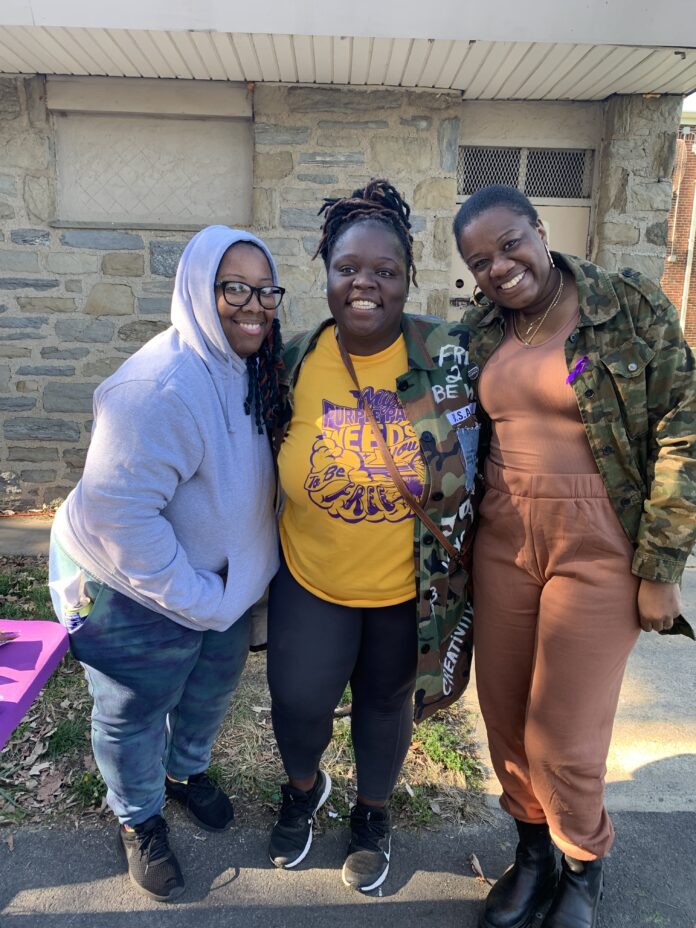
When it comes to providing care and resources for people who experience domestic violence or intimate partner violence (IPV), the unique needs of the LGBTQ community sometimes get overlooked. Collaboration between organizations is one way to ensure that the right services get to the people who have experienced IPV. Nhakia Outland, founder and executive director of the social justice and sexual health organization Prevention Meets Fashion (PMF), has been collaborating with Purple House Project, PA, founded by Christine Brunson for that reason.
Purple House Project’s mission is to “strengthen, empower and transition women impacted by intimate partner violence via connection to essential resources that aid in the healing process,” according to the organization’s website. Prevention Meets Fashion provides a host of resources and educational programs around sexual and interrelational health in Black and LGBTQ communities, often using fashion as a conduit. Both Outland and Brunson have backgrounds in social work.
“We started noticing that a lot of [Purple House Project’s] conversations were really not geared towards the LGBTQ community,” Outland said.
As Brunson and her colleagues at Purple House Project assist mostly women fleeing IPV, they make referrals to PMF when clients are in need of clothing. Outland would do her own assessment, and at times discover indications of sexual trauma among the women referred by Purple House Project. Outland handles the sexual trauma issues that people experience, and Brunson helps people navigate the domestic violence systems.
Outland explained that IPV can sometimes manifest differently for LGBTQ people than cishet people. Fear of being outed can lead to instances of IPV or domestic abuse being underreported, Outland said. “Or folks don’t believe them because it’s same-sex.”
Despite the underreporting of IPV cases among LGBTQ individuals, a 2018 report by the National Coalition Against Domestic Violence (NCADV) shows that 43.8% of lesbian women 61.1% of bisexual women have been raped, stalked or experienced physical violence at the hands of an intimate partner, as opposed to 35% of heterosexual women.
“Bisexual women actually report more abuse from male perpetrators, whether that be rape, stalking,” Outland said. There is also a dearth of data on IPV among gay men or men who have sex with men. But according to existing data via NCADV, 26% of gay men and 37.3% of bisexual men have been raped, stalked or experienced physical violence by an intimate partner, compared to 29% of heterosexual men.
In Philadelphia, staffers at the District Attorney’s Office Victim Services unit use an LGBTQ arrest identification sheet to single out crimes in the queer community. According to the Victim Services unit DATA Lab, the overall accuracy rate for the arrest tool is approximately 54%, and 71% of those detected cases have to do with domestic violence and IPV.
Although domestic violence shelters exist for people fleeing violence and abuse, discrimination in the shelter system may be a deterrent for trans people who are scared of being retraumatized, Outland pointed out.
“Same thing with the legal system,” Outland added. “In same-gender intimate partner violence or domestic violence relationships, police often arrest both partners compared to heterosexual cases.”
Both Outland and Brunson acknowledged that IPV can show up in many different ways. Outland pointed out that throughout her career, some common abuse tactics that she’s heard when it comes to IPV among LGBTQ people include perpetrators withholding hormones from their partner, outing their partner, threatening to physically harm them and denying the existence of abuse among LGBTQ folks.
Domestic violence and IPV exist beyond physical violence; they can manifest as mental, financial, cultural and sexual abuse, Brunson said. She cited gaslighting and “crazy-making” as forms of intimate partner violence.
“The financial abuse – I think we’re seeing more and more lately. People are either controlling the amount of money that their partner can have, or subsidizing a partner’s financial situation. When they finally do get the strength to leave, it’s really difficult for them to start over because they can’t get property in their name because of the financial sabotage that happens.”
Brunson cited untreated trauma and underdiagnosed or undiagnosed mental health issues as factors that perpetuate IPV. “I think it’s a combination of a lot of things,” she said. “We tell people the difference between domestic violence and toxic relationships is that it’s the unequal distribution of power and control.”
For people experiencing IPV who are considering seeking out help or services, Brunson advised that they be persistent because sometimes there are gaps in resources, and to have someone accompany them when they seek help.
“In addition to the trauma they experience, sometimes accessing the resources can be retraumatizing,” she said. “Sometimes you have to reshare your story, or you never know who you’re going to meet on the other end of the resource. I would encourage people to make sure, if they can, to have someone or reach out to an organization like Purple House Project or Prevention Meets Fashion to have someone accompany them as they’re navigating social services.”
As a potential preventive device, Outland plans to launch a youth gender-based violence project this coming January. It grew out of workshops focused on healthy relationships for youth that Outland has been leading in the community.
“The youth today are handling so many issues and gender-based violence is not just within their peer group,” Outland said. “They’re going to school and it may [come from] school officials, it may be parents.PMF has spoken out so many times about school administrators talking about what an LGBTQ student was wearing, or a female-identified student, what they were wearing. Something has to be done – these youth don’t deserve to be sexualized for what they’re wearing.”